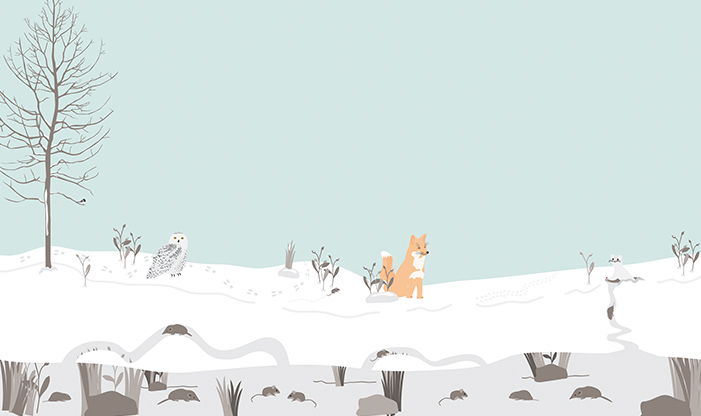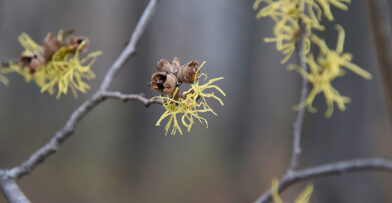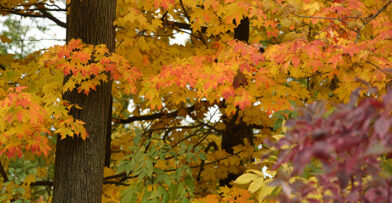Written with contributions from Aubrey Ellickson, Tom Finley, and Don Quintenz
Animals’ lifestyles are transformed by the accumulation of snow, and winter is often filled with animal activity that we can’t see. One place this happens is beneath the snow, where myriad animal relationships occur within the space of an ecology altered by weather conditions. This place is called the subnivean zone.
“Sub” means beneath, and “niv” translates from Latin as snow. The subnivean zone is an opening beneath the snow where small mammals live during winter, with connecting tunnels made by them to travel through, hunt prey, and gather plant material. In snow of six inches or more, the subnivean zone maintains a temperature at the ground surface around 32 degrees Fahrenheit, regardless of the air temperature above the snow. These zones mostly occur in prairies, and if you know where to look, you can often see traces of invisible lives hidden in plain sight in the form of ventilation holes, tunnel openings, and animal tracks.
How the Subnivean Zone Forms
A couple of processes can create a subnivean zone. One is snow build-up near a rock, shrub, or tall prairie grasses. Snow falls and accumulates, partially melts and then re-freezes, creating a harder layer. Often, a space exists under or beside the rock, shrub, or dead grasses where the snow has frozen. This open area will be preserved by the new snow. More snow may fall, freezing and creating more layers while leaving the open space intact.
Another method is through sublimation. Near the earth, it’s a little warmer than the ambient temperature. When snow falls and accumulates, a small cavity at the earth’s surface is created. Here, the snow can transform directly into a gas. This gaseous water will rise and refreeze at the top of the cavity formed by the melted snow, making a hard layer on the inside of it.
Inside the Subnivean Zone
Meadow voles and other mice live in the open spaces beneath the snow, subsisting on grasses, the bark of shrubs, and autumn seeds. The vole does very well by taking advantage of the niche made by the subnivean zone. Voles will actually create complete underground quarters with an eating room, bathroom, and sleeping room. They are successful because they can reproduce at any time of the year. Within the subnivean zone, weasels and shrews are the main predators. Weasels hunt voles and mice in the tunnels leading to the living spaces, doing so with a narrow body that can slide easily through small openings. Long-tailed and Short-tailed Shrews, who are in constant motion, also hunt in the subnivean zone, also eating voles and deer mice.
Outside the Subnivean Zone
Other animals exist on the surface of the snow, in the supernivean layer. These snow loving animals, known as chionophiles, have special adaptations that allow them to thrive in harsh winters. White-footed Mice have large feet, which allow them to travel on top of the snow at times, although they sometimes cache their food in the subnivean zone.
Owls, foxes, and coyotes, are able to take advantage of subnivean inhabitants by hunting from above. The ability of owls to hear, including irrupting Snowy Owls, is much greater than ours. They listen for activity beneath the snow and swoop in to capture prey when they sense movement. Foxes and coyotes, with their acute hearing, also listen for prey as well as sniff them out, pouncing on unsuspecting mice as they traverse through their tunnels. Foxes and coyotes are primarily nocturnal, and are able to hunt at dusk because of their incredible eyesight. In winter, they grow longer, thicker coats that allow them to hunt even in the coldest weather.
While weasels hunt within the subnivean zone, they spend much time outside it and wear a winter camouflage. They turn white, except for a dark spot at the tip of their tail. This black spot lures predators away from their body, preventing them from being caught.
Surviving the Snow
Eastern Gray Squirrels survive winter by relying on accumulated body fat, as well as storing nuts in small caches. They find their food through memory and a keen sense of smell, able to detect their cache under snow up to a foot deep. These squirrels live in insulated stick nests found in the forks of tree branches or in dens in living trees.
For some animals, snow can present a barrier to mobility and finding food. Raccoons will stay home if they have enough fat, though smaller ones will need to come out and hunt. Wolves follow each other’s footprints in the snow to help them move using less energy, assisting them through otherwise impassable terrain. Deer congregate under certain conditions to form deeryards in the forest. There is not as much snow and food is plentiful in them. These animals survive, but don’t thrive in the snow.
Without the Snow
Animals have adaptions for normal seasonal changes. Unpredictable weather patterns due to climate change can mean difficulty for some subnivean animals. When snow melts quickly or too soon, voles are vulnerable to being flooded out of their winter homes. Yet, if there is a winter without snow, voles can live a normal existence in the prairie. Weasels’ seasonal camouflage is based on day length. They develop their white winter coat at the same time each year even if there isn’t snow, making them more vulnerable to predators.
The subnivean zone is an invisible place for the most part, populated with creatures living out of view. Even though it goes mostly unnoticed by humans, this zone is crucial for a variety of animals to survive winter; those within the zone, and those on top of the snow.
Visit the Center on a snow-filled day to find animal tracks, traces to tunnel entrances, and discover clues to these hidden homes beneath the snow.


